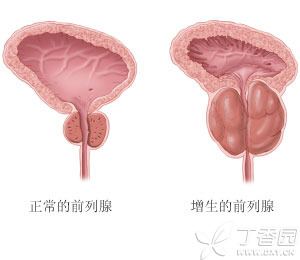1. Where is the prostate gland? What did you look like? Fig. 1 schematic diagram of prostate position the prostate is an inverted cone-shaped organ with a shape like a chestnut, and its normal size is about 3.5 cm × 2. 5 cm × 2. 5 cm. The prostate is close to the bladder above, gradually becomes the urethra downward, leans against the rectum behind, and the urethra and vas deferens pass through in the middle.
Do women have prostate gland?
I often meet an old man who comes to see a doctor in the clinic and ask him why he is not feeling well. He said to me with a solemn face: “I have prostate gland.” I said: “I also have prostate gland.” Prostate gland is a gonad organ unique to normal men, but women do not.
3. Prostate has what function?
Prostate gland is guarded at the junction of bladder and urethra. When prostatic hyperplasia occurs, it can squeeze urethra, causing urination obstruction. In addition, the prostate gland is the valve that controls urination and ejaculation. During ejaculation, the urethra on the bladder side is closed to prevent semen from flowing back into the bladder.
Prostate gland also has endocrine and exocrine functions: as endocrine gland, prostate gland secretes [prostaglandins], which enter blood; As an exocrine gland, prostate gland secretes prostatic fluid, which is an important component of semen and plays a role in nutrition and vitality enhancement of sperm.
4. What is the matter with prostatic hyperplasia?

Fig. 2 Prostatic hyperplasia
Prostatic hyperplasia is the abnormal enlargement of the prostate gland, which is manifested by the proliferation of internal cells of the prostate gland. The morphological size of the prostate gland increases, squeezing the urethra and blocking the bladder outlet, thus causing a series of urination symptoms.
Scholars at home and abroad have studied the etiology of benign prostatic hyperplasia for more than half a century, and various theories emerge in endlessly, but the exact etiology is still to be clarified. At present, it is unanimously recognized that [aging] and [existence of functional testis] are the necessary conditions for the occurrence of benign prostatic hyperplasia.
5. Do women have diseases similar to prostatic hyperplasia?
Prostate gland is a unique organ for men, but women sometimes have the same urination symptoms as men, such as dysuria and frequent urination, which we collectively refer to as [lower urinary tract symptoms]; Therefore, these urination symptoms of women have nothing to do with prostate gland, but are caused by organ diseases such as bladder or simple anxiety.
6. Who is more likely to suffer from prostatic hyperplasia?
Prostatic hyperplasia is one of the most common diseases among middle-aged and elderly men. Its incidence rate increases with age. By the age of 60, more than 50% of men suffer from benign prostatic hyperplasia, and by the age of 80, the proportion is as high as 83%.
Middle-aged and elderly men are more likely to have prostatic hyperplasia, provided there is [functional testis]. Domestic scholars have investigated 26 eunuchs of Qing Dynasty who underwent bilateral orchiectomy at the age of 10-26. The average age at the time of investigation was 72 years old. As a result, 21 people’s prostate gland was completely untouchable and the rest 5 people’s prostate gland atrophy was obvious.
7. What are the manifestations of prostatic hyperplasia?
The manifestations of benign prostatic hyperplasia include:
Symptoms during the urine storage period include increased urination frequency, especially anxious to find the toilet when there is a desire to urinate, unable to hold back urine or even urinate on pants;
Symptoms during micturition are mainly manifested as dysuria: including long waiting time when starting micturition, difficulty in micturition, intermittent micturition, thinning of urine line, shorter range of urine line, etc.
After urination, the symptoms are endless urination, and the urine ticks for a long time at the end of urination.
Complications mainly include hematuria, urinary tract and reproductive tract infection, renal function damage, bladder stones, inguinal hernia, rectocele, hemorrhoids, etc.
8. Is aerobic exercise helpful to prevent prostatic hyperplasia?
At present, there is no evidence that aerobic exercise has obvious correlation with prostatic hyperplasia.
9. Doctor how Confirms Prostatic Hyperplasia?
For middle-aged and elderly men over 50 years old, if they repeatedly or continuously suffer from symptoms such as increased urination times during the day, increased number of nights at night, or long waiting time for urination initiation, they should first consider benign prostatic hyperplasia and need to see a doctor. Doctors will make a definite diagnosis through medical history collection, [Prostate Symptom Questionnaire], digital rectal examination, prostate ultrasound, urine flow rate and other examinations.
Digital rectal examination is a common physical examination method in urology. Doctors use a finger to touch the prostate through the patient’s anus across the rectum, which can preliminarily understand the prostate and rectal lesions and anal tension within the range of fingers.
10. Why do you need blood tests for prostatic hyperplasia?
Among the indexes of blood test for patients with benign prostatic hyperplasia, urologists mainly value the indexes of serum creatinine and serum prostate specific antigen (PSA).
Serum creatinine can reflect renal function. If the patient has prostatic hyperplasia and serum creatinine elevation at the same time, further imaging examination is needed to see if there are hydronephrosis, ureteral dilatation reflux and other problems.
The detection of serum PSA should be based on a preliminary understanding of whether there is malignant lesion in prostate.
Other blood tests are conducted to find out if there are any contraindications for medication or surgery.
This article is exclusively authorized by the author to be used by Clove Garden and refuses any other form of reprinting.

